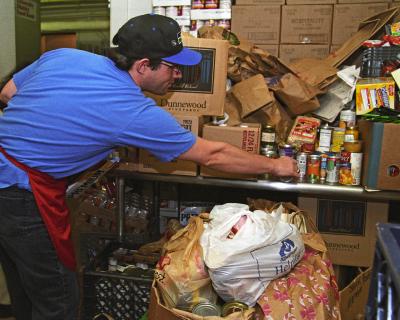January 6, 2005
Environmental Health & Safety a star in Food Bank giving
No matter how you measure it, the UW’s Environmental Health and Safety Department (EH&S) is a powerhouse when it comes to holiday donations.
This holiday season, as in the last several years, the department handily beat most all others on campus in gathering donations and cash for the University District Food Bank.
How did they do it? It started with intra-office competitions, and grew from there, said Jim Conery, administrative coordinator for the EH&S department.
| More on the food bank: Call 206-523-7060 or visit online at www.udistrictfoodbank.org |
“First we started with a contest, to get people motivated to donate more,” Conery said. “Environmental Health and Safety has five offices that serve different functions, and we had a competition between the different offices — one team competing against another, and that sort of stirred up some interest.” Now, he said, the department has evolved its donation process such that staffers make pledges that are matched by their colleagues.
A lot of interest, in fact. People brought food in by the bag for donation, or wrote checks instead, and Conery said one even made a special trip to Costco and filled up on goods to donate. “One person donated $200 and another bought almost another $200 worth by himself.”
In fact, EH&S has started collecting more cash than food in recent years. Conery explained, “One of the main reasons we started accepting cash and checks — and the food bank likes this too — is because we have many people who commute long distances on the bus or ferry and can’t carry heavy bags of groceries. That’s the only way they can donate.”
The EH&S Department collected and gave over $1,229 in cash — more than any other department — and 480 pounds of food. The numbers show the trend toward cash, Food Bank Director Joe Gruber said; in some previous years the department has raised upward of 1,000 pounds of food.
The food bank and EH&S count their donations in slightly different ways, with EH&S measuring by items donated and the food bank measuring more in total weight. The food bank weighs food donations and separates cash totals for tax purposes.
Out-raising EH&S in total food donations this year, but with a bit less cash, Gruber said, was Patient Data Services in Health Sciences.
Both Gruber and Conery are the type to deflect praise or compliments to their colleagues. Conery says it’s the EH&S staff members who make their donations so healthy. Gruber credits the food bank staff and its approximately 90 weekly volunteers, saying they helped the organization supply about a million pounds of supplemental groceries to about 90,000 people during, for instance, the 2003 calendar year.
A couple of departments got a late start so have extended their food drives into this month. But Gruber said he expects that when all the donations are counted from the UW campus, they will total about 6,400 pounds of food and about $1,860 in cash.
Gruber noted, too, that while the food bank receives huge donations around the holidays, its need for donations and volunteers continues throughout the year. Non-food items are also greatly appreciated; such as diapers, soap, toothpaste and toothbrushes, which are not covered by food stamps.
Conery said EH&S’s donating prowess was also prodded along because its director, Karen VanDusen, acknowleges the employees’ efforts at holiday parties and the like, making sure the efforts don’t go unnoticed.
For her part, VanDusen said she’s proud of the department. “These are good people who work here. They have heart. And I’m delighted to work with a group like that.”



